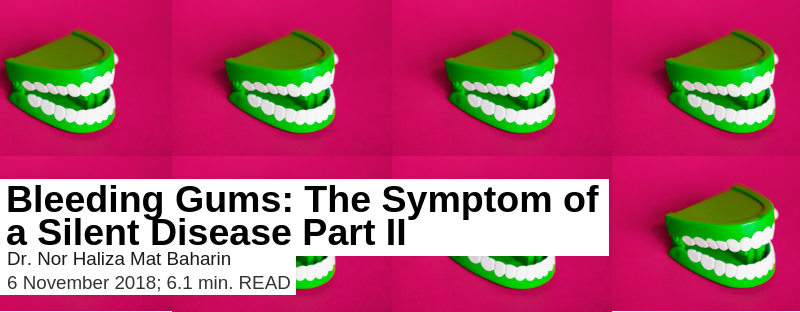Bleeding Gums: The Symptom of a Silent Disease Part II
Previously, in Bleeding Gums: The Symptom of A Silent Disease Part 1, I have explained to you about the two major types of gum disease and why they are often left undetected or undiagnosed until it is too late to be controlled.
The important takeaway from the earlier article is always pay attention to your gums. Experiencing bleeding gums during routine tooth brushing indicates that you are having a symptom of developing gum disease and thus, it should not be taken lightly.
In continuity, this time – I shall explain further on how the gum disease develops and useful measures, in which you can undertake to control it from becoming destructive and causing you a tooth loss.
If you recall in Part I, I have explained that there are two major types of gum disease: Gingivitis and Periodontitis. Both types of gum disease are caused by dental plaque. It is a soft deposit on our tooth that contains bacteria. It can be removed by brushing your teeth daily. However, if the dental plaque is not properly removed, slowly the gums adjacent to the area of plaque accumulation will become inflamed, fragile and bleed easily. This is partly a normal body response activated by the immune system in attempt to protect the periodontium from the bacteria.
Nevertheless, our immune system is like a double-ended sword where it protects the periodontium and at the same time, causing destruction of the periodontium if the cause of the disease (bacterial plaque) is not removed. During this inflammatory stage, white blood cells and inflammatory cytokines will be rushed to the periodontium to kill the bacteria. On the other hand, it will also activate the cell responsible for bone resorption. Starting with swollen and fragile gum, it then progresses to alveolar bone resorption causing the tooth to become loose and looking visibly longer.
Most people tend to avoid brushing at the bleeding area. However, by doing this, it only allows the plaque to accumulate and causing more destruction to the tooth supporting structures. As the plaque is getting thicker, it will also be calcified and hardened, and create what is known as calculus. The irregular surface of the calculus tends to encourage more plaque accumulation. Therefore, the key to prevent this disease is by practising good oral hygiene.
How about those who brushes their teeth diligently every day, but still ends up with having bleeding gums? Brushing your teeth can only remove the dental plaque. When there is already calculus presents in the oral cavity, a mere brushing will no longer be an effective measure. Hence, to remove the calculus and remaining plaque on the teeth, you have to schedule for scaling and polishing, which are the services provided in a professional teeth cleaning in any dental clinic.
Some people expect that by frequently brushing or brushing with more forcefully, it will remove the dental plaque effectively. This is not true because the brushing technique is more important. Cleaning your teeth with heavy force and, or with hard-bristle type of toothbrush should be avoided, as it could remove healthy tooth structure and causes the gums to recede.
There are several types of standard brushing techniques, which I can suggest for controlling the dental plaque effectively. Namely Bass Technique, Stillman Technique, Charter Technique and their modifications. However, if you go for a dental check-up, the dentist will be able to advise for a suitable brushing technique according to your dentition and oral condition.
On top of that, you might want to consider to floss religiously- at least once daily. Flossing is often ignored because it is considered an extra steps but by sticking to brushing routine alone may not be able to get rid of the dental plaque completely especially, if it is in between the teeth.
What about using mouth gargle after brushing the teeth? Will it help reduces the risk of gum disease? Yes, it can reduce the risk or gum disease and slows down of its progress. However, this method cannot beat the control provided from using a correct brushing technique and regular flossing. Mouth gargle tends to be effective for protecting the teeth when they are already free from the dental plaque.
In order to prevent gum disease, brushing your teeth is the key. However, do not simply focusing on its frequency, it should be routinely done with a proper oral hygiene aid and technique. Yes, gum disease can be treated, but attention should also be given to the cost and treatment time required especially, if the disease is more in advanced stage. It is better to prevent this silent disease rather than experiencing all the discomforts, which can affect the quality of your life later. Prevention, as the old saying, is better than cure.

Dr. Nor Haliza Mat Baharin works as a Periodontist and Clinical Lecturer in Periodontology for the Faculty of Dentistry in Universiti Sains Islam Malaysia.
Contact info: lytzar@gmail.com




